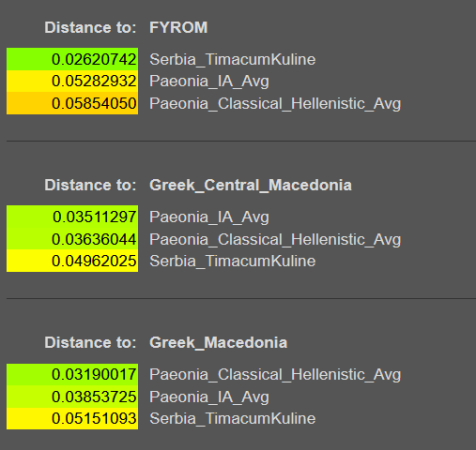Macedonia_BA:I7231,0.130897,0.148267,0.012068,-0.023902,0.025235,-0.009203,0.0047,-0.000923,0.008999,0.031709,0.00065,0.005395,-0.011596,-0.001239,-0.016694,-0.000265,0.004433,0.003674,0.008045,-0.01038,-0.018967,0.009398,0.000123,0.000602,0.000239
Macedonia_Classical_Hellenistic:I10167,0.113823,0.147252,-0.009428,-0.040052,0.007386,-0.014502,-0.005875,-0.00923,-0.007567,0.000911,0.011367,0.009891,-0.013379,0.006331,0.000814,-0.01896,-0.000261,0,0.009427,0.017133,-0.002121,-0.00272,-0.001602,-0.008073,-0.000838
Macedonia_Classical_Hellenistic:I10390,0.129758,0.15436,0.02753,-0.024225,0.028928,-0.005578,-0.00376,-0.005769,0.007567,0.025878,0.003248,0.01139,-0.015758,0.004129,-0.006515,-0.0118,-0.007171,-0.004814,0.001383,-0.015507,-0.00836,0.004946,0.001602,0.006266,-0.004311
Macedonia_Classical_Hellenistic:I10391,0.121791,0.159438,0.018102,-0.025517,0.027697,-0.01757,-0.007755,-0.007154,0.010226,0.032074,0,0.007194,-0.007582,0.008945,-0.015336,-0.014054,-0.007432,0.005574,0.009427,-0.01113,-0.014849,0.001855,-0.002835,0.00241,-0.000359
Macedonia_IA:I7233,0.119514,0.158423,0.007165,-0.045866,0.028313,-0.015897,-0.002115,0.002308,0.014317,0.039545,0.006496,0.009591,-0.019921,-0.007982,-0.034202,-0.009679,0.008605,0.003041,0.00817,-0.013256,-0.007487,0.013973,-0.006532,0.002771,-0.005149
Macedonia_IA:I8112,0.12862,0.142174,0.026021,-0.011951,0.034468,-0.011992,-0.00188,0.001154,0.003272,0.023691,0.001624,0.008093,-0.020069,-0.01913,-0.006243,0.009679,0.016168,0.005828,0.003394,-0.007504,0.001123,-0.004204,-0.001109,0.003012,-0.008861
Macedonia_IA:I10379,0.129758,0.149283,0.024136,-0.029716,0.028313,-0.016176,0.005405,-0.000923,0.000205,0.03426,-0.003573,0.011839,-0.010258,-0.003853,-0.017236,0.0118,0.029597,-0.00038,0.006662,-0.002376,-0.018093,0.000866,-0.001232,0.007109,-0.004311
Macedonia_IA:I10381,0.136588,0.151314,0.026398,-0.030685,0.029852,0.000279,-0.001175,-0.002538,0.008181,0.049022,-0.000325,0,-0.015758,0.003441,-0.0095,-0.006232,0.006389,0.00152,0.004902,0.005002,-0.008859,-0.000495,0.003081,-0.001205,0.013651
Macedonia_IA:I10383,0.12862,0.15436,0.025267,-0.017119,0.032929,-0.010319,0.001175,-0.002308,0.002863,0.036447,-0.006658,0.012289,-0.016799,-0.015551,-0.013843,0.0118,0.024121,0.005701,0.00993,-0.002626,-0.008235,-0.001113,-0.00037,0.006145,-0.003473
Macedonia_IA:I10384,0.125205,0.155376,0.023759,-0.006137,0.022466,-0.001673,-0.000235,0,0.007363,0.025513,0.002598,0.007044,-0.017393,-0.006193,-0.010315,0.003182,0.004694,0.003801,0.003897,-0.016008,-0.013227,-0.00272,-0.007888,0.003133,-0.006706
Macedonia_IA:I10385,0.122929,0.148267,0.024136,-0.006137,0.02185,-0.001394,-0.00141,-0.002538,-0.005113,0.018406,0.009094,0.010041,-0.013379,0.001376,-0.001493,-0.012331,-0.005737,0.003294,0.005279,-0.009379,-0.007986,0.006554,0.001602,0.005422,0.00455
Macedonia_IA:I10387,0.117238,0.160454,0.014331,-0.020026,0.030775,-0.006693,-0.009165,0.001385,-0.000409,0.042643,0.005846,0.006594,-0.025718,-0.008257,-0.018594,-0.004243,-0.007562,0.003167,0.016969,-0.015132,-0.010357,0.009274,-0.002095,0.011568,-0.003233
Macedonia_IA:I10388,0.125205,0.156392,0.018479,-0.017119,0.027697,-0.008925,0.00188,-0.004154,0.005113,0.03098,0.00341,0.009741,-0.012785,-0.005643,-0.014115,-0.002121,0.008214,0.0019,0.004399,-0.012006,-0.010606,0.008656,0.007518,0.007953,-0.005868
Macedonia_IA:I10389,0.125205,0.149283,0.025644,-0.008398,0.016926,-0.011713,0.0047,-0.005307,-0.003068,0.014761,0.012017,-0.000749,-0.011298,-0.016239,-0.008279,0.002519,0.013951,0.009502,0.007416,0.001626,-0.019466,0.024854,0.000493,0.020123,-0.004191
Macedonia_Classical_Hellenistic_Avg,0.12179067,0.15368333,0.012068,-0.029931333,0.021337,-0.01255,-0.0057966667,-0.0073843333,0.0034086667,0.019621,0.0048716667,0.0094916667,-0.012239667,0.0064683333,-0.0070123333,-0.014938,-0.0049546667,0.00025333333,0.0067456667,-0.003168,-0.0084433333,0.0013603333,-0.000945,0.000201,-0.001836
Macedonia_IA_Avg,0.1258882,0.1525326,0.0215336,-0.0193154,0.0273589,-0.0084503,-0.000282,-0.0012921,0.0032724,0.0315268,0.0030529,0.0074483,-0.0163378,-0.0078031,-0.013382,0.0004374,0.009844,0.0037374,0.0071018,-0.0071659,-0.0103193,0.0055645,-0.0006532,0.0066031,-0.0023591


